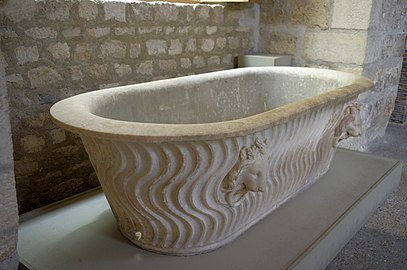Lutetia
 Model of Lutetia in 3rd century AD (Archeological Crypt under Parvis of Notre Dame de Paris Cathedral) | |
| Alternative name | Lutetia Parisorum (Latin), Lutèce (French) |
|---|---|
| History | |
| Periods | 1st century BCE to 5th century |

The Roman city of Lutetia (also Lutetia Parisiorum in Latin, in French Lutèce) was the predecessor of present-day Paris and the home of the Parisii, a Gallic tribe. Traces of Neolithic settlement was found on the present site. It was an important crossing point of the Seine, and meeting point of land and water trade routes. In the 1st century BCE, it was conquered by Romans and was gradually rebuilt into a Roman city. Monumental remains, including a forum, amphitheater, and Roman baths still remain. In the 5th century it became the capital of the Merovingian dynasty of French Kings, and thereafter was known simply as "Paris".
Etymology[]
The settlement is attested in Ancient Greek as Loukotokía (Λoυκoτοκία) by Strabo and Leukotekía (Λευκοτεκία) by Ptolemy.[1] Likely origins are Celtic root "Lut" meaning " a swamp or marsh", or the Latin term "nutum", or "mud".[2] It survives today in the Scottish Gaelic lòn ("pool, meadow") and the Breton loudour ("dirty").[3]
A less likely origin is the Celtic root *luco-t-, which means "mouse" and -ek(t)ia, meaning "the mice" and which is contained in the Breton word logod, the Welsh llygod, and the Irish luch.[1]
Earliest inhabitants[]

Traces of Neolithic habitations, dating as far back as 4500 BCE, have been found along the Seine at Bercy, and close to the Louvre, The earliest inhabitants lived on the river plain, raising animals and farming. In the Bronze Age and Iron Age, they settled in villages, in houses made of wood and clay, which could be easily dismantled and moved if needed. Their life was closely attached to the river, which served as a trade route to other parts of Europe.[4]
The Gallic settlement[]

The original location of Lutetia, the early capital of the Parisii, is still disputed by historians. Traditionally, historians had placed the settlement on the Île de la Cité, where the bridges of the major trading routes of the Parisii crossed the Seine. This view was challenged after the discovery between 1994 and 2005, during the construction of highway, of a large early Gallic settlement in Nanterre, in the suburbs of Paris. This is composed of a large area of several main streets and hundreds of houses over 15 hectares. Critics also point out the lack of the archeological findings from the pre-Roman era on the Ile-de-la-Cité.[5]
Other scholars dispute the idea that Lutetia was in Nanterre. They point to the description given by Julius Caesar, who came to Lutetia to negotiate with the leaders of the Gallic tribes. He wrote that the oppidum, or fortress of Lutetia, which he visited, was on an island. In his account of the war in Gaul, "De Bello Gallico", Caesar wrote that, when the Romans later laid siege to Lutetia, "the inhabitants had burned their structures and the wooden bridges which served to cross the two branches of the river around their island fortress," which appears to describe the Île de la Cité.[6]
Proponents of the Ile de Cité as the site of the Gallic settlement also address the issue of the lack of archeological evidence on the island. The original oppidum and bridges were burned by the Parisii to keep them out of the hands of the Romans. The houses of the Parisii were made of wood and clay. Since then every square meter of the island has been dug up and rebuilt, often using the same materials, multiple times, making it unlikely that traces of the Gallic settlement would remain on the island. They argue that a settlement in Nanterre did not necessarily exclude that the Île-de-la-Cité was the site of the oppidum of Lutetia; both settlements could have existed at the same time. Finally, they argue that, while Gallic settlements sometimes relocated to a new site, the new sites were usually given a new name. It would be very unusual to transfer the name of Lutetia from the Nanterre settlement to a new Roman town on the Île-de-la-Cité. They also point out that argue that if Lutetia had not already existed where Paris is today, the new Roman city would have been given a Latin, not a Gallic name. This seems to support the argument that Lutetia was in fact located at the center of modern Paris.[4][7]
The Parisii first agreed to submit to Caesar and Rome, but In 52 BC they joined other tribes, led by Vercingetorix, in a revolt near the end of Julius Caesar's Gallic Wars, the Battle of Lutetia was fought with the local tribe.[8] The Gallic forces were led by Vercingetorix's lieutenant Camulogenus. They burned the oppidum and the bridges to keep the Romans from crossing. The Romans, led by Titus Labienus, one of Caesar's generals, marched south to Melun, crossed the river there, marched back toward the city, and decisively defeated the Parisii. The location of the final battle, like the location of the oppidum, is disputed. It was fought near a river, which some historians interpret as the Seine, and others as the Yonne; and near a large marsh; a feature of the countryside near both the Île-de-la-Cité and Narbonne. Whatever its location was, the battle was decisive; Lutetia became a Roman town.[6][7]
Roman Lutetia[]
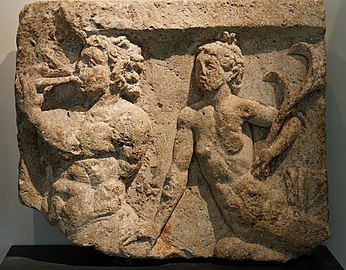
Sculpture of a Triton and a Nymph (2nd century AD) found on the Île de la Cité (Musée Carnavalet)
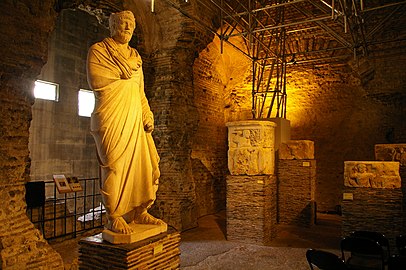
Roman baths, (Hotel de Cluny)
The first traces of the Roman occupation of Lutece appeared at the end of the 1st century BCE, during the reign of the Emperor Augustus. At the beginning of the 1st century AD, the construction of a Roman city was already underway.[9]
The new Roman city was laid out along the "Cardo Maximus" or central axis of Lutece, which was directly perpendicular to the Seine and the bridges on Île de la Cité. It began at the heights of the Montagne Sainte-Geneviève on the left bank, went downhill along the modern Rue Saint-Jacques, across a marshy area to the bridge connecting to the Île de la Cité; across the island, and across a bridge to a smaller enclave on the right bank. The low-lying land along the river was suitable for farming, Since it was easily flooded, the road was raised.[10] though the land was still initially suitable for farming.[11]

Lutetia occupied an area of about 54 hectares, and had a population of about eight thousand persons.[12] It was not the capital of the Roman province (Sens had that distinction) and it was to the west of the most important Roman north-south road between Provence and the Rhine. The importance of the city was due in large part to its position on important meeting place of land and water trade routes. One of the most striking archeological finds from the early period is the Pillar of the Boatmen which was erected by the corporation of local river merchants and sailors and dedicated to Tiberius.[13][11] It featured statues of both Roman and Gallic deities, Excavations along the river have turned up bronze coins minted by the Parisii, as well as amphorae of wine from Italy and ceramics from Lyon and Italy. [9]
The city was constructed on the model of Rome, with a forum, baths, and an arena. The principal axis of the city was the Cardo Maximus. a roughly north-south road which ran from the heights of Mount Sainte-Genevieve on the left bank, down to the bridges over the Île de la Cité, and across to a small enclave on the north, or right bank, at the modern Rue Saint=Martin. Since the left bank was marshy and frequently flooded, the center of the city was higher up the scope, where the Cardo Maximus met the Decumanus, or east-west Main Street, located at modern rue Soufflot. Here the Romans constructed a civic basilica, containing a tribunal, and a temple. Gradually the city was furnished with a forum, and baths, all on the upper slope of Mount Sainte-Genevieve.[14]
Major public works projects and monuments were built in the 2nd century AD. An aqueduct fifteen kilometres long was constructed to bring water from the plateau of Rungis, south of the city. It took the form of a bridge over the valley of Bièvre river at Arcueil-Cachan. The piers and ruined arches are still visible, and their arches give the location its name.[15]
In the 3rd century, according to legend, Christianity was brought to the town by St Denis, and his companions Rusticus and Eleuthere. In about 250 AD he and two companions were said to have been arrested and decapitated on the hill of Mons Mercurius thereafter known as Mons Martyrum (Martyrs' Hill, or Montmartre). According to tradition, he carried his head Saint-Denis, where the Basilica of Saint-Denis was later built The first documented bishop of Paris was Victorinus, in 346. The first council of Bishops in Gaul convened in the city in 360. When Saint Martin visited the city in 360, there was a cathedral, near the site of Notre-Dame de Paris.
The mid third century brought a series of invasions of Gaul by two Germanic peoples, the Franks and the Alemanni, which threatened Lutetia. The city at the time had no fortifications. Portions of the left bank settlement, including the baths and amphitheater, were hurriedly abandoned, and the stones used to construct ramparts around the Île de la Cité. The city was reduced in size from one hundred hectares during the high Roman Empire to ten to fifteen hectares on the left bank, and ten hectares on the Île de la Cité.[16] A new civic basilica and baths were built on the island. Their vestiges can be seen today in the archeological crypt under the Parvis in front of Notre-Dame Cathedral, Square John Paul II.[10] [16]
In the 4th century, Lutetia remained an important bulwark defending the Empire against the Germanic invaders. In 357–358 Julian II, as Caesar of the Western empire and general of the Gallic legions, moved the Roman capital of Gaul from Trier to Paris. After defeating the Franks in a major battle at Strasbourg in 357, he defended against Germanic invaders coming from the north. He was proclaimed emperor by his troops in 360 in Lutetia. Later Valentinian I resided in Lutetia for a brief period (365–366).[17]
The end of the Roman Empire in the west, and the creation of the Merovingian dynasty in the 5th century, with its capital placed in Paris by Clovis I, confirmed the new role and name for the city. The adjective Parisiacus had already been used for centuries. Lutetia had gradually became Paris, the city of the Parisii.[18]
The Forum of Lutetia[]

Only a small part of a wall of the old forum remains above ground today, but the foundations have been extensively excavated since the 19th century. The Forum of Lutetia was modelled after that of Rome, and was in the center of the Roman city, between the modern streets of Boulevard Saint-Michel on the west, Rue Saint-Jacques on the east, rue Cujas to the north and Rue G. Lussac and rue Malbranch to the south. It was three Roman blocks down the hillside from the still-existing Roman baths of Cluny. It was two Roman blocks wide and one block long, 177.6 meters by 88.8 meters. The center of the forum was where the intersection of rue Soufflot and rue V. Cousin is today.[19]
The forum was surrounded by a wall, with entrances on the north and south. Along the outer walls on the north, south sides and west sides, were arcades sheltering rows of small shops. At the west end was an underground gallery, or crypto-portico.[20]
The civic basilica, essentially the town hall, occupied the east of the forum, It contained the courts where political, social and financial issues were discussed and decided. It had a central nave, higher than other parts of the building, and two lower collateral aisles, separated from the nave by rows of columns. This model was later adapted by Christian cathedrals.[19]
At the west end was the temple, devoted to the official gods. Its classical facade with a portico of pillars had a triangular fronton, or pediment, faced to the east, the tradition for Roman temples and later Christian cathedrals.[19][20]
The Amphitheater, or Arenes de Lutece[]
The ancient Amphitheater, or "Arenes" of Lutetia

Model of the ancient amphitheater with its stage and arena
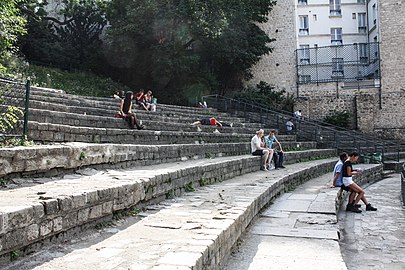
The seats of the amphhitheater
The Amphitheater of Lutetia, or Les Arenes de Lutece, located near the meeting place of Rue Monge and Rue de Navarre, was a large outdoor amphitheater and arena. It had a stage and backdrop used for the presentation of plays, along with a larger space suitable for the combat of gladiators and of animals, and other large-scale festivities. Though there is no specific evidence to date the beginning of construction, it was probably built near the end of the 1st century AD. It was largely dismantled in the early 4th century so that the stones could be used in the construction of the fortress on the Île de a Cité, at a time when the province was threatened by barbarian invasion. Many of the remaining stones were reused in another major project, the city wall of Paris constructed by Philippe-Auguste in the 12th century.[21]
The site was discovered in 1867-68 during the construction of Rue Monge by Louis-Napoleon, and excavations were begun in 1870.[21][22] An omnibus depot was planned to be built on the same site, but a coalition of notable Parisans, including Victor Hugo, insisted that the remaining vestiges be saved. They were declared a monument, and partially rebuilt between beginning in 1915-16.
The Arena is about 100 meters by 130 meters in size, making it one of the largest in Gaul. It could accommodate as many as seventeen thousand spectators.
The Theater[]
The Roman theater of Lutetia (not to be confused with the amphitheatre, or Arenes de Lutece) was located where the Lycée Saint-Louis is today, along Boulevard Saint-Michel, in the center of the grid of ancient Roman roads. It occupied one of the standard blocks of the Roman city, three hundred Roman feet on each side. It was probably built in the second part of the 1st century AD, based on coins found in the foundation; was rebuilt 2nd century, and, like many other buildings on the left bank, In the 4th century it was taken apart its stone used in the building of the wall and new buildings on the Île-de-la-Cité. in the 4th century It was discovered underneath the Lycée Saint-Louis on Boulevard Saint-Michel, and with other portions discovered under Rue Racine and the School of Medicine. It was gradually excavated and recreated by Theodore Vacquer between 1861 and 1884.[23]
The slope of Mt. Genevieve was used to provide elevation for the semi-circular seating on the uphill side. [23] The back of the stage, which no longer exists, faced onto to the Roman road, was decorated with arches and columns. The "pulpitum", or front stage, and "parascenum", or back stage, rested on a base of cement. When they were excavated in the 19th century, the columns and walls were gone but the chalk markings of the Roman architect were still visible on the floor. [23]
The theater had two groups of seating; the "maenianum", or general audience seating, higher up and farther back, and the "maenianum" of the podium, for the notables, in front of the orchestra stage. It had a separate entrance, and was accessed by a covered corridor. There were also several "vomitoria", or underground passageways, to the seats of the ordinary spectators. The arena probably had some form of covering over the seats to protect spectators from rain, but no trace of one has bee found. [23]
The Cluny Baths[]
Model of Thermes de Cluny: In the center is the frigidarium; to the left is the tepidarium; in front of the tepidarium is the caldarium.Photo: Wiki user Maryas
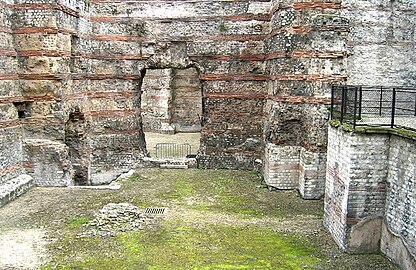
The Caldarium, or hot baths, of Cluny
Bath in the Frigidarium, or Cold bath

Remains of the Hypocaust under-floor passages that heated the baths
The Thermes de Cluny, the grand public baths, now part of the Musée de Cluny, are the largest and best-preserved vestige of Roman Lutetia, The baths have occupied he same site, at the meeting point of the two major Roman roads, between Boulevard Saint-Michel, Boulevard Saint-Germaine, and the Rue des Ecoles, since the late 1st or early 2nd century AD.[24] The baths originally occupied a much larger area than they do today. Their was is three hundred Roman feet wide, a standard Roman city block, and about four hundred Roman feet long, It covered about one hectare of land.[25] The site today contains both the baths and the adjoining the National Museum of the Middle Ages.* [26]
The clients entered the baths through a doorway near the modern Rue des Ecoles, into a large courtyard that was lined with shops. They would cross the courtyard to the entrance of the baths, change their clothes, and go first into the caldarium, a very hot and steamy room with benches and a pool of heated water. The room was heated by a Hypocaust, an under-floor system of tunnels filled with hot air, heated by furnaces tended by slaves.slaves. The caladium had benches and a large hot-water pool. After a period of time there, when they began to sweat, they would move to the frigidarium, which had a cold-water pool and baths, or to the tepidarium, which had the same features at room-temperature.
The baths were much more than a place to bathe; they played an important social and political role in Lutetia and other Roman cities. They were free of charge, or accessible for a small fee, and contained not only baths but also bars, places to rest, meeting rooms and libraries.[26]
The original baths were probably destroyed during the first invasion by the Franks and Alamans in 275, then rebuilt. The frigidarium, with its vault intact, and the caldarium are the main remaining chambers. They were originally covered on the inside with mosaics, marble or frescoes. The northern side was occupied by two gymnasia and the centre of the facade monumental fountain. Beneath there are several lower chambers with vaulted galleries. The drain for emptying the frigidarium pool is still visible. Water flowed out through a drain that encircled the baths and ran into a main drain located under Boulevard Saint-Michel.[24]
The vestiges of other baths have survived. THE best-preserved were found in the 19th century, not far from Cluny, within and nearby the present College de France. on the "Cardo" or rue Saint-Jacques. They were part of a bath complex that was even larger than Cluny, about two hectares. It had two parts; a "Paestra", or large outdoor exercise area, and the baths themselves. Vestiges of the circular hot water pool and the cold water pool have survived. along with the mains of the hypercaust heating system under the floor. Traces were also found of marble wall coverings, frescoes and bronze fixtures.[27]
The Île de la Cité[]
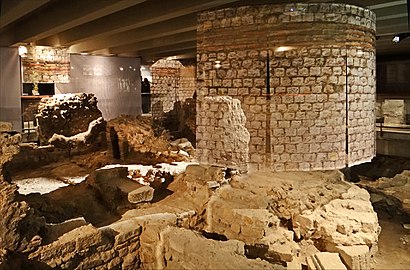
Ruins of the Roman baths under the Parvis Notre-Dame – Place Jean-Paul-II

A coin depicting the Julian (360-363) made Roman Emperor by his soldiers in Lutetia
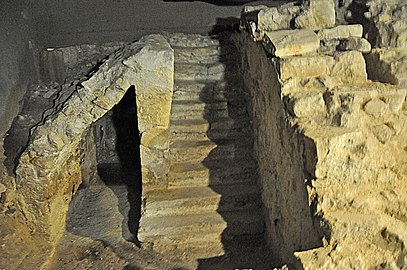
Steps to the wharf of the Roman port, now fifty meters from the river.( Parvis Notre-Dame – Place Jean-Paul-II)
Beginning in 307 AD, the increasing number of invasions of Gaul by Germanic tribes Gaul forced the Lutetians to abandon a large part of the city on the left bank, and to move to the Île de la Cité. They used the stones from the abandoned forum and other buildings to construct a rampart around the island, as well as a civic basilica approximately where the flower market is located today.[28]
Vestiges of the ramparts of the island were found under the parvis of Notre-Dame de Paris, when an underground parking lot was constructed in 1965. The rampart was not very high; only about two meters; suggesting that it was the base of a gallery wooden wall. The rampart, as well as most of the buildings on the island, were built top stones brought from the demmolished buildings on the left bank, particularly from the amphitheater. The rampart later was a refuge for the Parisians when Lutetia was besieged by the Vikings in 886-887. Portions of the rampart can be seen today at the Parvis Notre-Dame – Place Jean-Paul-II, in the archeological crypt under the Parvis.[28]
A modest headquarters or "Palace" was constructed at the west end of the island, where the Palais de Justice is today. One was the residence and headquarters of the Roman military commander, and the temporary residence of two Roman Emperors during the military campaigns. It was probably here that Julian was proclaimed emperor by his troops in 361. During the Merovingian dynasty, this site saw the cconstruction of the palace of the Kings of France, before the construction of the Louvre palace.[28]
A second important building on the island was the civic basilica, fulfilling the judicial functions transferred from the Left Bank. It stood between the modern Rue de la Cité and the Tribunal of Commerce, near where the flower market is today. It was discovered in 1906 during the construction of the Paris Metro station. It was very large, seventy meters long and thirty-five meters wide, with a central nave to two lower collatera sections. The entrance was probably on the Rue de la Cité, portion of the Cardo Maximus which crossed the island and connected the bridges It also was largely constructed of stones taken from the demolished buildings of the left bank, including some highly decorative carved stones which probably came from the Forum.[28]
Many artifacts from Lutetia have been recovered and are on display at the Musée Carnavalet.
Streets[]
The new streets and squares were laid out with great precision, in blocks ("insular") of exactly 300 Roman feet (88.8 meters) square. As a result the modern Rue Saint Martin and Rue Saint-Denis, both laid out in Roman times, are exactly 600 Roman feet apart, though in some smaller areas, particularly on the Ile de La Cité, the street grid had to be adjusted to the space.[29]
The roads were built in the Roman style. The land was cleared, given a slight rounded slope remove water, and covered with an aggregate of small river stones, which was tamped down. channels were dug on either side to take away water. either side. Sidewalks were constructed in the same manner, and sometimes covered with yellow clay. They were regularly maintained throughout the time of the Roman Empire. Modern excavations of the streets often find the ruts in the roads from the wheels of chariots and wagons. The roads were regularly recharged with fresh stones, gradually raising their height by as much as a meter.[30]
Residences[]
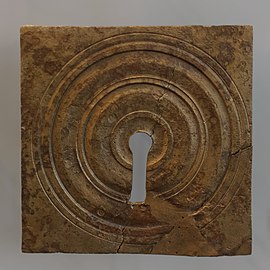
A Roman keyhole plaque
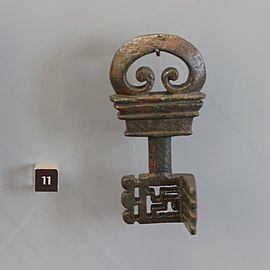
A bronze key from Lutetia (Musée Carnavalet)

Objects from daily life in Lutetia found in the Musée Carnavalet
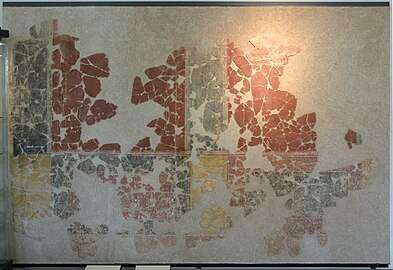
Remains of a decorative mural from 12, rue de l'Abbé-de-l'Épée, (2nd century AD} (Musée Carnavalet)

Detao; of a fresco of a bird, 14, rue Monsieur-le-Prince, Musée Carnavalet)
The residential streets of Lutetia, unlike the boulevards, were irregular and not as-well maintained. They apparently were the responsibility of the home-owners, not the city. Several early residential neighbourhoods dating to the beginning of the 1st century AD, particularly on the Rue de l'Abbé de l'Épée, rue Pierre-et-Marie-Curie, and the garden of the Êcole des Mines. Traces of these residences survived because they were fossilised by a fire.[31]
The houses generally had wood frames covered with clay on the outside. The wooden beams of roof and walls were fastened held together with notches, reinforced with nails. The roof was usually thatched, or sometimes covered with tiles.The floors were covered with yellow clay or packed earth. Excavations showed that the city had an important plaster industry; plaster was used to simulate stone, as a all covering, or in the form of bricks and tiles.[32]
THe houses of the wealthy often had an under-the-floor heating system and their own baths similar to those o civic baths on a small scale. Their interior walls were covered with plaster, and often painted with frescoes, some traces of which have been recovered (See gallery). They frequently had a reception room on the ground floor, and bedrooms upstairs, accessed by a stairway, as well as a cellar. which sometimes had its own well. Sometimes several houses were grouped together with a common courtyard, which sometimes had an oven and other common cooking facilities. [31]
In May 2006, a Roman road was found during expansion of the University of Pierre and Marie Curie campus. Remains of private houses dating from the reign of Augustus (27 BC – 14 AD) and containing heated floors were found. Everyday items like flowerpots, bronze chains, ceramics, and drawer handles were found. The owners were wealthy enough to own baths found in one of the homes, a status symbol among Roman citizens.
Aqueducts[]
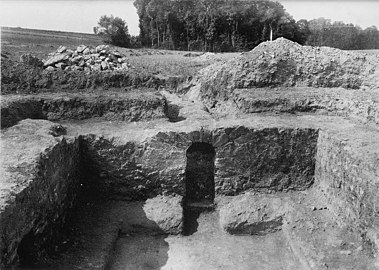
Excavation of beginning of the aqueduct at Wissous (1903 photo)
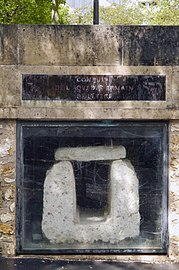
Section of the Roman aqueduct on Avenue Reille, (14th Arr.)

A section of aqueduct near Square Montsouris
Residents had access to traditional water supplies, such as rainwater and river, and numerous wells have been found. However, the baths and city fountains required a considerably larger supply. Several reservoirs were constructed in the hills outside the city at Rungis and Wissou in the present department of the Essonne. Together they could deliver an estimated two thousand cubic meters of water a day. The masonry and cement conduit, about half a meter wide and three quarters of a meter deep, set into the ground and hermetically sealed, trailed a distance of twenty-six kilometres to the city. The major obstacle it faced was crossing the canyon of the river Biévre. The conduit was raided atop arches and pillars, some of which still exist in the Valley of Aecuiel-Cachan. The date of the aqueduct is not precisely known, but is believed to be after the second half of the 1st century AD. Vestiges of another aqueduct was later discovered under the Institute Curie, perhaps connected to the first, which carried water to the baths of the College de France.[33]
Cemeteries[]
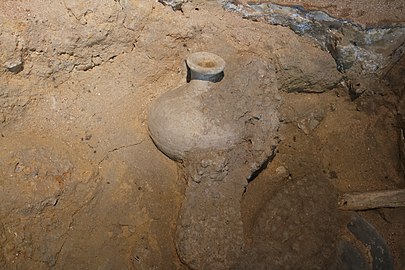
Pottery and a shoe sole from a tomb in the necropolis of Saint-Jacques (Carnavalet Museum)

Tombstone of a cavalier defeating a barbarian (High Roman Empire - Carnavalet Museum)
During the early, or High Roman Empire, the major Roman necropolis, or cemetery, was located, following tradition, near the Cardo Maximus, or Main Street, close to the exit of the city and some distance from the nearest residences. The Necropolis of Saint-Jacques was close to the modern intersection of Avenue Saint-Michel and Avenue Denfert-Rochereau, close to Avenue saint-Jacques. It occupied a space of about four hectares, and was in use from the beginning of the first until about the 4th century AD. About for hundred tombs, only a small part of the original number, have been excavated. Tombs were often placed one above the other. Some remains were buried in stone sepulchres, others in wooden coffins, others simply in the ground. It was common bury the dead with some items of their belongings, usually some of their clothing and particularly their shoes, placed in vases. Sometimes items of food and silverware were placed in the burial vessel. vases with food were buried nearby. Small statues of the defunct or preferred gods were often found in tombs, Sometimes coins were placed in the mouth, or in the hand, of the deceased, to pay the fee of Charon, the mythical boatmen to the other world. The tombs of prominent people were usually marked with statues or steles. These were nearly always later displaced, and reused in walls in other sites. A Few monumental tombs of the prominent also existed, but were dismantled and the stone used for other purposes over the centuries.[34]
In the later Empire, when the pressure of invading Germanic tribes led to the abandonment of the old monuments a new necropolis, named for Saint-Marcel. was established near the modern and Boulevard du Port Royal, along the Roman main road leading to Italy. In this necropolis the tombs were mostly composed of stone taken from the monuments in the earlier necropolis of Saint-Jacques. One of the tombs there, dating from the Third Century AD. is notable for the first recorded use of the name "Paris" for the city. The tombs at Saint Marcel contain a variety of ceramic and glass objects from the workshops of the city, placed at the foot of the deceased. The first symbols of Christian burials, in the 5th century, were found here.[35]
Art and Decoration[]
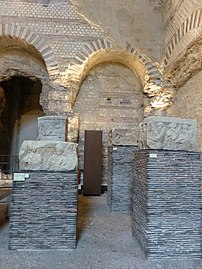
Piecds of the Pillar of the Boatmen displayed in the Baths of Cluny

Jupiter holding a lightning bolt, on the Pillar of the Boatmen (1st century AD)

Hunting scene decorating the Cluny baths

Figure of Venus, bronze and cast iron (1st-4th c. AD -Carnavalet Museum)

A stele of the god Mercury, found under the Hotel Dieu on the Île-de-la-Cité (Carnavalet Museum)
Lutetia was both a trading center for art works, through its access to water and land routes, and, later, the home of workshops ceramics and other decorative works. Sculpture was widely used in monuments, particularly in the several necropoli, or Roman cemeteries, in the outskirts of the city.
The best-known work of sculpture found in the city is the Pillar of the Boatmen, dedicated to the Emperor Tiberius and donated to the city in about 14-17 AD, by the guild of boatmen, the most influential guild in the city. It depicted both Roman and Gallic deities is a series of blocks stacked into a column. It was discovered in the Île-de-la-Cité.[33]
Legacy[]
Several scientific discoveries have been named after Lutetia. The element lutetium was named in honor of its discovery in a Paris laboratory, and the characteristic building material of the city of Paris—Lutetian Limestone—derives from the ancient name. The "Lutetian" is, in the geologic timescale, a stage or age in the Eocene Epoch. The asteroid 21 Lutetia, discovered in 1852 by Hermann Goldschmidt, is named after the city.
Lutetia is featured in the French comic series The Adventures of Asterix, most notably in Asterix and the Golden Sickle, Asterix and the Banquet and Asterix and the Laurel Wreath.
See also[]
References[]
- ^ Jump up to: a b La langue gauloise, Pierre-Yves Lambert, éditions errance 1994.
- ^ Albert Dauzat et Charles Rostaing, Dictionnaire étymologique des noms de lieux en France, éditions Larousse 1968.
- ^ Dictionnaire de la langue gauloise, Xavier Delamarre, éditions errance 2003.
- ^ Jump up to: a b Paris Antique -THe First Inhabitants- Ministry of Culture site
- ^ Nanterre et les Parisii : Une capitale au temps des Gaulois ?, Antide Viand, ISBN 978-2757201626
- ^ Jump up to: a b Sarmant, "History of Paris" (2012), p. 10
- ^ Jump up to: a b Busson 2001, p. 32.
- ^ Julius Caesar: De Bello Gallico,, book six, VI p. 62
- ^ Jump up to: a b Busson 2001, p. 32-33.
- ^ Jump up to: a b Fleury, M., "Lutetia Parisiorum", The Princeton encyclopedia of classical sites, (Richard Stillwell, William L.MacDonald, and Marian Holland McAlister,eds.) Princeton, N.J. Princeton University Press. 1976
- ^ Jump up to: a b "Paris, a Roman city". www.paris.culture.fr.
- ^ Sarmant & 2012), p. 12.
- ^ Busson (2001), p. 154.
- ^ Sarmant 2012, p. 12.
- ^ 2 Roman and Medieval Paris, Clifton Ellis, PhD Architectural History, Texas Tech College of Architecture - TTU College of Architecture
- ^ Jump up to: a b Sarmant 2012, p. 14.
- ^ Goudineau, Christian, "Lutetia" in Dictionary of Antiquity under the direction of Jean Leclant. PUF. 2005
- ^ The City of Antiquity Archived 2008-12-12 at the Wayback Machine, official history of Paris by The Paris Convention and Visitors Bureau
- ^ Jump up to: a b c Busson 2001, p. 64-66.
- ^ Jump up to: a b Paris Antique -The Forum - Ministry of Culture site
- ^ Jump up to: a b Busson 1989, pp. 80-89.
- ^ Ministry of Culture Paris archaeology site- the theater|https://archeologie.culture.fr/paris/en/theatre
- ^ Jump up to: a b c d Busson 2001, p. 94-97.
- ^ Jump up to: a b Alain Bouet and Florence Saragoza, "Les Thermes de Cluny", the Archeologia files, no. 323, p. 25
- ^ Busson, p. 106.
- ^ Jump up to: a b "Paris, a Roman city" (in English) French Ministry of Culture site
- ^ Busson 1989, pp. 102-105.
- ^ Jump up to: a b c d Busson 1989, p. 132-133.
- ^ Busson 2001, p. 40.
- ^ Busson 2001, p. 45.
- ^ Jump up to: a b Busson 1980, p. 47-49.
- ^ [1] Paris Antique site- Plaster production
- ^ Jump up to: a b Busson 1989, p. 98-100.
- ^ Busson 1989, p. 120-131.
- ^ Busson 1989, p. 18-129.
- ^ "Roman aqueducts: Paris (country)". www.romanaqueducts.info.
Bibliography (in French)[]
- Busson, Didier (2001). Paris ville antique (in French). Monum- Éditions du Patrimoine. ISBN 978-2-85822-368-8.
- Fierro, Alfred (1996). Histoire et dictionnaire de Paris. Robert Laffont. ISBN 2-221--07862-4.
- Sarmant, Thierry (2012). Histoire de Paris: Politique, urbanisme, civilisation. Editions Jean-Paul Gisserot. ISBN 978-2-755-803303.
- Schmidt, Joel (2009). Lutece- Paris, des origines a Clovis. Perrin. ISBN 978-2-262-03015-5.
Further reading[]
- Philippe de Carbonnières, Lutèce: Paris ville romaine, collection Découvertes Gallimard (no. 330), série Archéologie. Éditions Gallimard, 1997, ISBN 2-07-053389-1.
External links[]
| Wikimedia Commons has media related to Lutetia. |
- "Paris, a Roman city" (in English) French Ministry of Culture site
- Arènes de Lutèce - Paris Parks & Gardens
- The Aqueduct[1]
- ^ Cite error: The named reference
Roman aqueducts: Paris countrywas invoked but never defined (see the help page).
- Archaeological sites in France
- Celtic towns
- Populated places in pre-Roman Gaul
- Roman Paris
- Roman towns and cities in France







